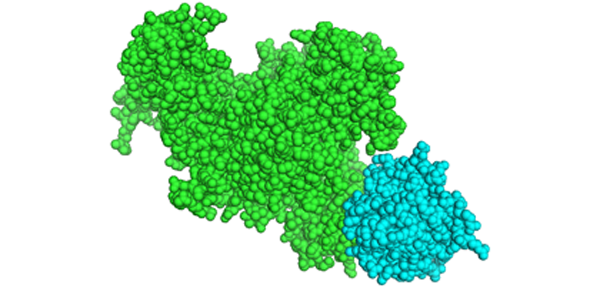
Image of interacting proteins courtesy Dr Lucy Colwell
Dr Lucy Colwell has helped develop an algorithm which models how proteins inside cells interact with each other, shedding light on how proteins work together and aiding our understanding of how living systems work.
“Being able to predict these interactions will help us understand how proteins work together to complete tasks such as turning food into energy," says Lucy, a theoretical and computational chemist in the department, who worked with Ned Wingreen and colleagues at Princeton University on the research.
The ability to generate huge amounts of data from genetic sequencing has developed rapidly in the past decade, but the trouble for researchers is in being able to apply that sequencing data to better understand living systems. This new research is a significant step forward because biological processes are driven by specific protein-protein interactions.
“We were really surprised that our algorithm was powerful enough to make accurate predictions in the absence of experimentally-derived data,” says Lucy. “And using an algorithm is much faster and much cheaper than relying on experiments.”
When proteins interact with each other, they stick together to form protein complexes. In her previous research, Lucy found that if the two interacting proteins were known, sequence data could be used to figure out the structure of these complexes. Once the structure of the complexes is known, researchers can then investigate what is happening chemically.
However, the question of which proteins interact with each other still required expensive, time-consuming experiments.
In a paper published in PNAS, the researchers used a mathematical algorithm to sift through the possible interaction partners and identify pairs of proteins that interact with each other. The method correctly predicted 93% of protein-protein interactions present in a dataset of more than 40,000 protein sequences for which the pairing is known, without being first provided any examples of correct pairs.
The researchers thought that the algorithm would only work accurately if it first ‘learned’ what makes a good protein-protein pair by studying pairs that have been discovered in experiments. But they found they could run the algorithm without giving it any such training pairs. “The fact that we didn't need a set of training data was really surprising,” says Lucy.
The algorithm was developed using two well-studied families of proteins, histidine kinases and response regulators from bacteria, and the researchers are now extending the technique to other organisms. “Reactions in living organisms are driven by specific protein interactions,” says Lucy. “This approach allows us to identify and probe these interactions, an essential step towards building a picture of how living systems work.”
The research was supported in part by the National Institutes of Health, the National Science Foundation and the European Union.
This article was excerpted from a longer article on the University of Cambridge research news webpages.
